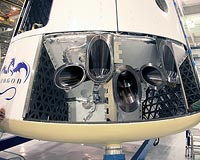 |
Greenbelt MD (SPX) Sep 28, 2009 A plant that lives along muddy waterways in Asia has inspired a NASA team to develop a special coating to prevent dirt and even bacteria from sticking to and contaminating the surfaces of spaceflight gear. Researchers at NASA's Goddard Space Flight Center in Greenbelt, Md., are developing a transparent coating that prevents dirt from sticking in the same way a lotus plant sheds water - work begun through collaboration with Northrop Grumman Electronics Systems, Linthicum, Md., and nGimat Corporation, Atlanta, Ga. Although a lotus leaf appears smooth, under a microscope, its surface contains innumerable tiny spikes that greatly reduce the area on which water and dirt can attach. "If you splash lotus leaves with water, it just beads up and rolls off, indicating they have a special hydrophobic or water-repelling ability," said Eve Wooldridge, the James Webb Space Telescope (JWST) Project Contamination and Coatings Lead at Goddard. "This ability also prevents dust from adhering to the leaves." This special quality is what the NASA team is attempting to replicate to prevent dirt from accumulating on the surfaces of spacesuits, scientific instruments, robotic rovers, solar array panels and other hardware used to gather scientific data or carry out exploratory activities on other objects in the solar system. The trick is developing a coating that can withstand the harsh space environment.
Originally Developed to Reduce Window Cleaning "Indeed, the ability to replicate these properties could prove invaluable to NASA," said Wanda Peters, Principal Investigator for NASA's lotus coating research and Lead of Goddard's Coatings Engineering Group. During the Apollo moonwalks, for example, such a technology could have prevented the highly abrasive lunar dust from adhering to astronauts' spacesuits: "I think one of the most aggravating, restricting facets of lunar surface exploration is the dust and its adherence to everything no matter what kind of material, whether it be skin, suit material, metal, no matter what it be and its restrictive, friction-like action to everything it gets on," said Apollo 17 Commander Eugene Cernan during the Apollo 17 Technical Crew Debriefing. "However, the coating as it was originally formulated will not be able to withstand the harsh environmental conditions found in space," Peters said. The Goddard team has experimented with and tested different formulas to determine their suitability for spaceflight. "No one formula will meet all our needs," added Peters. "For example, the coating that's applied to spacesuits needs to stick to a flexible surface, while a coating developed to protect moving parts needs to be exceptionally durable to resist wear and tear." The Goddard team has met with exploration systems engineers at NASA's Johnson Spaceflight Center, Houston, Texas, to demonstrate the modified coatings and get mission requirements. Besides spacesuits and moving parts, it could be applied to solar panels and radiators, where cleanliness keeps them operating at their maximum potential.
Addition of Bacteria-Killing Biocide NASA could apply the same biocide-infused coating on a planetary lander to prevent Earth-borne bacteria from adhering and potentially contaminating the surface of an extraterrestrial object. The team believes this version of the coating may have commercial interest to hospitals as well. "We are modifying and testing the formula to ensure it can withstand all the challenges our hardware will encounter - extreme temperatures, ultraviolet radiation, solar wind, and electrostatic charging. Outgassing of the coating also must be addressed for use inside astronauts' habitation areas," Peters added. "We also are making sure it remains durable and cleanable in the space environment." "We have a great team," said Peters. "Goddard is the only NASA center researching this type of coating, and we believe continued research will deliver great benefits to NASA's exploration missions and will produce many positive applications outside NASA." In addition to Peters and Wooldridge, the Goddard team includes Sharon Straka, Danielle Voce and Kristen McKittrick (wet chemistry development); Marcello Rodriguez (cleaning and durability testing); Craig Jones, Maryjane Stephenson and Scott Freese (characterization testing); Cory Blake Miller (qualification testing); Amani Ginyard (research); Mark Hasegawa and Jack Triolo (coatings formulation consultants); and Lon Kauder (space environmental testing). This research is also supported by the Exploration Technology Development Program's Dust Management Project, led and managed by NASA's Glenn Research Center, Cleveland, and is one of several technologies being assessed and developed by this project for application to space exploration missions. Share This Article With Planet Earth
Related Links Goddard Space Flight Center Space Tourism, Space Transport and Space Exploration News
 Dragon/Falcon 9 Update
Dragon/Falcon 9 UpdateHawthorne CA (SPX) Sep 25, 2009 We are now only a few months away from having the inaugural Falcon 9 launch vehicle on its launch pad at Cape Canaveral and ready to fly! The actual launch date will depend on a variety of factors, including weather and the overall launch schedule at the Cape, so that is a little harder to predict. Based on prior experience, launch could be anywhere from one to three months after Falcon 9 is int ... read more |
|
| The content herein, unless otherwise known to be public domain, are Copyright 1995-2009 - SpaceDaily. AFP and UPI Wire Stories are copyright Agence France-Presse and United Press International. ESA Portal Reports are copyright European Space Agency. All NASA sourced material is public domain. Additional copyrights may apply in whole or part to other bona fide parties. Advertising does not imply endorsement,agreement or approval of any opinions, statements or information provided by SpaceDaily on any Web page published or hosted by SpaceDaily. Privacy Statement |